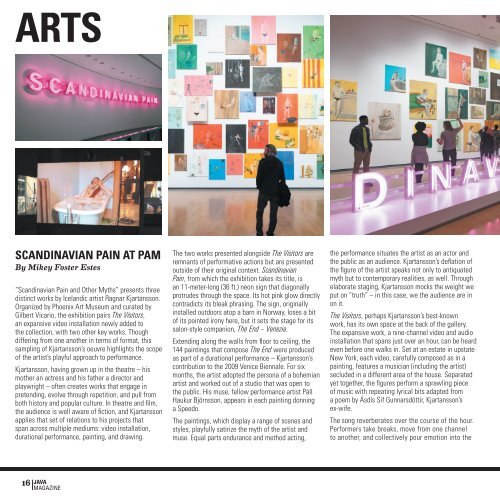Java.JAN.2019-Singles
Create successful ePaper yourself
Turn your PDF publications into a flip-book with our unique Google optimized e-Paper software.
ARTS<br />
SCANDINAVIAN PAIN AT PAM<br />
By Mikey Foster Estes<br />
“Scandinavian Pain and Other Myths” presents three<br />
distinct works by Icelandic artist Ragnar Kjartansson.<br />
Organized by Phoenix Art Museum and curated by<br />
Gilbert Vicario, the exhibition pairs The Visitors,<br />
an expansive video installation newly added to<br />
the collection, with two other key works. Though<br />
differing from one another in terms of format, this<br />
sampling of Kjartansson’s oeuvre highlights the scope<br />
of the artist’s playful approach to performance.<br />
Kjartansson, having grown up in the theatre – his<br />
mother an actress and his father a director and<br />
playwright – often creates works that engage in<br />
pretending, evolve through repetition, and pull from<br />
both history and popular culture. In theatre and film,<br />
the audience is well aware of fiction, and Kjartansson<br />
applies that set of relations to his projects that<br />
span across multiple mediums: video installation,<br />
durational performance, painting, and drawing.<br />
The two works presented alongside The Visitors are<br />
remnants of performative actions but are presented<br />
outside of their original context. Scandinavian<br />
Pain, from which the exhibition takes its title, is<br />
an 11-meter-long (36 ft.) neon sign that diagonally<br />
protrudes through the space. Its hot pink glow directly<br />
contradicts its bleak phrasing. The sign, originally<br />
installed outdoors atop a barn in Norway, loses a bit<br />
of its pointed irony here, but it sets the stage for its<br />
salon-style companion, The End – Venezia.<br />
Extending along the walls from floor to ceiling, the<br />
144 paintings that compose The End were produced<br />
as part of a durational performance – Kjartansson’s<br />
contribution to the 2009 Venice Biennale. For six<br />
months, the artist adopted the persona of a bohemian<br />
artist and worked out of a studio that was open to<br />
the public. His muse, fellow performance artist Páll<br />
Haukur Björnsson, appears in each painting donning<br />
a Speedo.<br />
The paintings, which display a range of scenes and<br />
styles, playfully satirize the myth of the artist and<br />
muse. Equal parts endurance and method acting,<br />
the performance situates the artist as an actor and<br />
the public as an audience. Kjartansson’s deflation of<br />
the figure of the artist speaks not only to antiquated<br />
myth but to contemporary realities, as well. Through<br />
elaborate staging, Kjartansson mocks the weight we<br />
put on “truth” – in this case, we the audience are in<br />
on it.<br />
The Visitors, perhaps Kjartansson’s best-known<br />
work, has its own space at the back of the gallery.<br />
The expansive work, a nine-channel video and audio<br />
installation that spans just over an hour, can be heard<br />
even before one walks in. Set at an estate in upstate<br />
New York, each video, carefully composed as in a<br />
painting, features a musician (including the artist)<br />
secluded in a different area of the house. Separated<br />
yet together, the figures perform a sprawling piece<br />
of music with repeating lyrical bits adapted from<br />
a poem by Ásdís Sif Gunnarsdóttir, Kjartansson’s<br />
ex-wife.<br />
The song reverberates over the course of the hour.<br />
Performers take breaks, move from one channel<br />
to another, and collectively pour emotion into the<br />
16 JAVA<br />
MAGAZINE

















